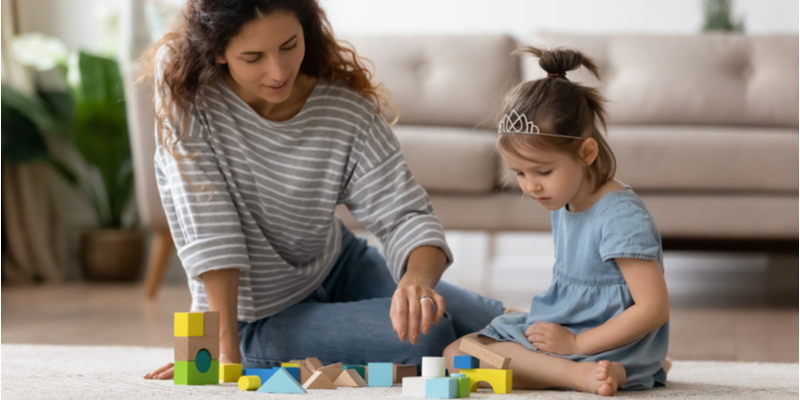Top tips to help children develop their speech and language at home
by Bethanie Hancox on Jun 28, 2021

Back in April 2021, the BBC highlighted how lockdown has “hurt” the language skills of young children. So, it’s no surprise that young children are requiring more support with their language skills. The closures of early years settings, reduced access to vital health services and the changes in interactions with others, have all taken their toll.
We know that early language skills are the biggest predictor of later academic outcomes and success (Bleses, D., Markransky, G., Dale, P.S., Hojen, A. and Ari, B.A. (2016)) and early vocabulary skills can predict academic achievement 10 years later (Applied Psycholinguistics, 37(6), pp.1461–1476). Therefore, the development of these skills is more important than ever.
But it’s not all doom and gloom! Parents, teachers and early years staff have done an amazing job at supporting young children during this time, with limited resources and reduced ability to expose their children to new experiences. And now (dare I say it) things are getting back to some sort of normality, we can start to focus on supporting our little ones even more.
The Communication Pyramid
As I say, we’re well on the way to getting back on our feet, so let’s see how we can build on those language skills at home using the ‘communication pyramid’ as a guide. As a Speech and Language Therapist, I often get asked how language skills can be supported at home and I always direct parents to this communication pyramid.

It’s a really simple tool that explains how children’s speech, language and communication skills develop. Children typically develop their skills in a sequential pattern, starting from the bottom and working their way up. It’s important that children develop each skill and build on what they have learnt to enable them to be effective communicators. So using the pyramid, here are my top tips for supporting language development at home:
Attention and Listening
Eliminating Background Noise
Technology has become a central way to how we communicate, work and interact with each other. When used the right way, it has an essential place in developing children’s language and communication skills. Watching television or using devices such as iPads, provides children with opportunities to observe what other people are doing and saying. However, if noise is present in the background continually, it can hinder a child’s ability to listen and tune in to what’s going on around them. It’s all about getting the balance right! When interacting with your child:
- Reduce as much background noise as possible, such as turning the television off
- Get down to your child’s level, call their name and wait for them to look at you before you begin to talk. This way, you will have your child’s attention and they are more likely to be able to process the information you have given them
Bubble Play
Everyone loves bubbles! They are a key resource for all Speech and Language Therapists, as they are highly motivating and can do so much to support a child’s attention and listening skills, as well as develop their functional communication.
- Try getting down to your child’s level, calling their name and saying “bubbles”. At this point, your child will either point to the bubbles, look at you or even try to grab them! All of these actions are communicative intents, so acknowledge them by saying “Sophie wants bubbles”
- When your child is focused on you, blow bubbles and model language such as “bubbles”, “pop”, “quick” etc
- When the bubbles have been popped, your child is likely to use those communicative intents again. This is your opportunity to say “more bubbles?” and even use a sign alongside to support their understanding of ‘more’

Play and Interaction
Turn-Taking
The ability to take turns is an essential conversational skill. When we talk to each other, we take turns to be the listener and the responder. Children start to develop this skill very early on through play. To support your child to develop this skill, consider playing games that encourage your child to wait, and where more than one person gets a turn. Have a go at some of these simple, yet effective games.
- Building a tower. Take it in turns to put a piece on the top. Ensure you model the phrases “my turn, your turn”, “Daddy’s turn, Charlie’s turn”
- Rolling a ball to each other. Increase the number of people in the game so your child has to learn to wait longer
- Using a car ramp, taking it in turns to push a car down. This is a great toy to use to help children understand cause and effect. Modelling language such as “ready..steady….go!” helps your child to stay engaged within that interaction
Understanding Language

Keeping Communication Age-Appropriate
When we are interacting with children, it is so important to ensure our language matches the level of the child’s understanding. 'Key words' or 'information-carrying words' are the number of important words in a sentence that a child has to understand in a given instruction, in order for them to follow it successfully. Children don’t need to understand every single word in a sentence, just the ones that carry meaning.
Examples of keyword-level instructions:
For each of these instructions, a choice of objects would be given to the child. If there are no choices, this would mean there are 0 keywords to understand.- 1 keyword – “show me the spoon”
- 2 keywords – “show me the big teddy”
- 3 keywords – “put the dolly under the table”
- 4 keywords – “give the big cake to the little dog”
Children typically develop their understanding of keywords by the following ages:
|
Key word level |
Age |
|
1 keyword |
1 year old |
|
2 keywords |
2 years old |
|
3 keywords |
3 years old |
|
4 keywords |
4 years old |
It’s important to keep your language as simple as possible when giving your child instructions, always taking their keyword-level understanding into consideration. Children find it easier to process language when you chunk longer instructions into bite-size pieces, simplify and give them time to respond.
Talking
 Comments and Questions
Comments and Questions
As adults, all we want is for our children to talk. To be able to express themselves and engage in conversations. However, it’s easy to think that we can help children do this by asking them lots of questions. In fact, this can have the opposite effect and can actually make a child say less, particularly if they don’t have the language required to respond. Questions can be really important and useful to ask but only when you really need to know the answer. Try commenting rather than questioning:
- Using really simple language, comment on what your child is doing or looking at
- Your child will begin to map these words onto the objects/actions you are commenting on, especially when they are motivated by them
- If your child uses any single word, expand on what they have said by adding another word. For example, if your child says ‘“car”, you could say “yes, big car”
Speech Sounds

Modelling
As children start to develop their use of speech sounds, you may find that these sounds are not always clear or easy to understand. Sometimes, children may miss out on sounds in words or substitute sounds for others.
One of the key strategies that we give to parents is to model clear speech sounds and to try not to correct your child or make them produce a sound that they are finding difficult. By giving your child opportunities to hear the correct production of sounds in words, it enables them to store these sounds accurately, for example:
- If your child has said a word unclearly, repeat the word back to them, modelling the correct sounds
- If your child sees a key and says “tea!”, respond with “you’re right! It’s a key!”
- Show interest in what your child is saying, not just how they are producing sounds
- Go on a ‘sound hunt’ – gather objects that begin with the target sound and hide them around your home. As your child finds them, you can model the vocabulary for them, emphasising the target sounds
When to get help from a speech therapist?
 If your child is having difficulty making themselves understood or has difficulty understanding what is said to them then they may benefit from an assessment. Mable therapy has a team of highly qualified therapists ready to work with you and your child. It's useful to find a therapist you feel you connect with so I would advise browsing the directory to find the best therapist for you.
If your child is having difficulty making themselves understood or has difficulty understanding what is said to them then they may benefit from an assessment. Mable therapy has a team of highly qualified therapists ready to work with you and your child. It's useful to find a therapist you feel you connect with so I would advise browsing the directory to find the best therapist for you.
If you would like my advice about who would be a good fit for your child you can call and speak to me or one of my speech and language colleagues.
- General mental health (36)
- General Speech & Language (31)
- Primary Schools (25)
- School Issues (25)
- Classroom Behaviour (24)
- Counselling (24)
- Anxiety (22)
- Absenteeism (21)
- Speech and Language Therapy (21)
- SENCOs (19)
- Safeguarding (18)
- Secondary & Sixth Form Schools (17)
- Social Communication (17)
- Funding (15)
- MATs (15)
- Generalised anxiety (14)
- Autism Support (11)
- Language Delay/Disorder (11)
- SEMH (11)
- Relationship Issues (10)
- AAC (7)
- ADHD Support (7)
- Speech Sounds (7)
- Autism (5)
- Hearing Impairment (5)
- Depression (4)
- Selective Mutism (4)
- Anger (3)
- Cleft Lip/Palate (3)
- Downs Syndrome (2)
- Phobias (2)
- Stammering (2)
- Loss (1)
- Self-Harm (1)
- Suicidal Thoughts (1)
You may also like
These related stories

My child mispronounces words – how can I help them?

Developing Oracy Skills at Key Stage 2 with Speech Therapy Strategies
